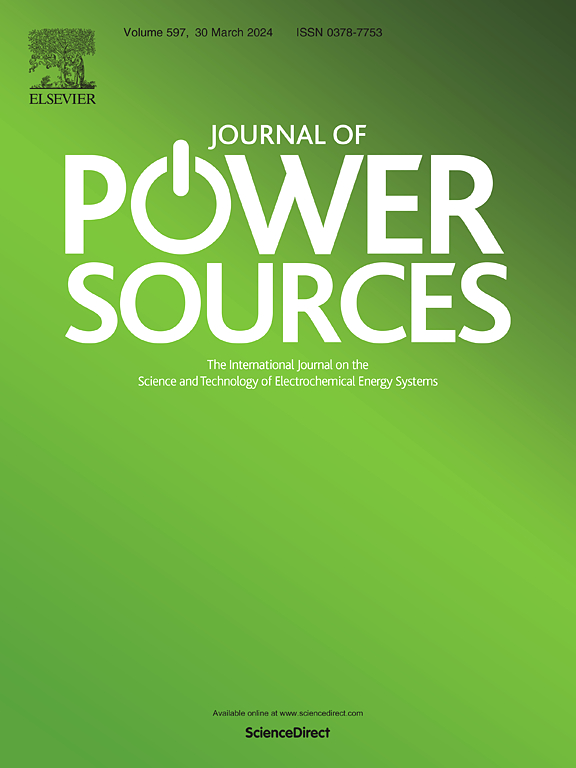用于合成燃料发电的熔融碳酸盐电解槽
IF 8.1
2区 工程技术
Q1 CHEMISTRY, PHYSICAL
引用次数: 0
摘要
在向二氧化碳中性循环经济过渡的过程中,电子燃料生产的创新解决方案势在必行。本研究探讨了熔融碳酸盐电解的潜力,利用可逆熔融碳酸盐燃料电池技术(该技术因其在大规模发电和二氧化碳捕集方面的功效而广受认可),通过熔融碳电解槽模式为电子燃料生产开辟了一条突破性的道路。通过仔细研究 rMCFC 在各种热流参数下的电化学行为,我们对其在电解模式下的运行进行了深入分析,从而为通过电化学反应生产高效气体燃料开辟了一条前景广阔的道路。实验研究包括电流-电压评估和电化学阻抗光谱分析,为电池的性能状况提供了一个清晰的视角。此外,还在死前和死后阶段使用了扫描电镜显微镜,有助于深入了解材料降解机制。我们的研究结果不仅提高了当代人对可逆电池操作的理解,还划定了有利于优化燃料电池和电解模式的关键操作参数,为未来循环经济中高效、可持续的电子燃料生产指明了一条极具前景的道路。这项研究是利用熔融碳酸盐电解技术实现高效电子燃料生产生态系统的重要里程碑。本文章由计算机程序翻译,如有差异,请以英文原文为准。
Molten carbonate electrolyzer for synthetic fuel generation
In the transition to a CO2-neutral circular economy, innovative solutions for e-fuels production are imperative. This study delineates the potential of molten carbonate electrolysis, utilizing a reversible molten carbonate fuel cell technology, recognized for its efficacy in large-scale electrical power generation and CO2 capture, to steer a groundbreaking pathway to e-fuels production through molten carbon electrolyzer modality. By meticulously scrutinizing the rMCFC's electrochemical behavior under assorted thermal-flow parameters, we offer an incisive analysis of its operation in the electrolysis mode, thereby unveiling a promising avenue for high-efficiency gaseous fuel production through electrochemical reactions. The experimental study includes current-voltage assessments and electrochemical impedance spectroscopy analysis, providing an elucidative view of the cell's performance landscape. Moreover, SEM microscopy was employed in both pre- and post-mortem stages, facilitating a deep understanding of material degradation mechanisms. Our results not only enhance the contemporary comprehension of reversible cell operations but also delineate the pivotal operating parameters that are conducive to optimizing both fuel cell and electrolysis modes, signposting a highly promising route to efficient and sustainable e-fuels production for the future circular economy. This study stands as a critical milestone in harnessing the molten carbonate electrolysis technology as a corner stone on the roadmap towards achieving a high-efficiency e-fuels production ecosystem.
求助全文
通过发布文献求助,成功后即可免费获取论文全文。
去求助
来源期刊

Journal of Power Sources
工程技术-电化学
CiteScore
16.40
自引率
6.50%
发文量
1249
审稿时长
36 days
期刊介绍:
The Journal of Power Sources is a publication catering to researchers and technologists interested in various aspects of the science, technology, and applications of electrochemical power sources. It covers original research and reviews on primary and secondary batteries, fuel cells, supercapacitors, and photo-electrochemical cells.
Topics considered include the research, development and applications of nanomaterials and novel componentry for these devices. Examples of applications of these electrochemical power sources include:
• Portable electronics
• Electric and Hybrid Electric Vehicles
• Uninterruptible Power Supply (UPS) systems
• Storage of renewable energy
• Satellites and deep space probes
• Boats and ships, drones and aircrafts
• Wearable energy storage systems
 求助内容:
求助内容: 应助结果提醒方式:
应助结果提醒方式:


